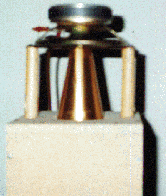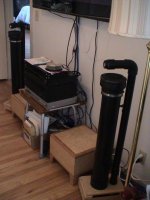Aside from the distributed-mode units mentioned above, in the realm of roughly pistonic operation it's quite simple--just keep the radiating aperture less than half a wavelength (ideally a quarter wavelength) wide at its highest operating frequency.
Of course, that's easy at 100hz, but not easy at all at 20kHz, where half a wavelength is slightly more than half an inch.
Here are some exotic suggestions:
.5" tweeters in a 1d or 2d Bessel array (increases power handling)
slot-loaded mid and tweeter (yes, I believe it is possible)
a .5" Karlson tube.
corona discharge spike tweeter
Of course, that's easy at 100hz, but not easy at all at 20kHz, where half a wavelength is slightly more than half an inch.
Here are some exotic suggestions:
.5" tweeters in a 1d or 2d Bessel array (increases power handling)
slot-loaded mid and tweeter (yes, I believe it is possible)
a .5" Karlson tube.
corona discharge spike tweeter
Aside from the distributed-mode units mentioned above, in the realm of roughly pistonic operation it's quite simple--just keep the radiating aperture less than half a wavelength (ideally a quarter wavelength) wide at its highest operating frequency.
Of course, that's easy at 100hz, but not easy at all at 20kHz, where half a wavelength is slightly more than half an inch.
Here are some exotic suggestions:
.5" tweeters in a 1d or 2d Bessel array (increases power handling)
slot-loaded mid and tweeter (yes, I believe it is possible)
a .5" Karlson tube.
corona discharge spike tweeter
Much appreciated.. love the suggestions!
Why not get a CBT36 kit?
Parts Express presents the CBT36 Line Array Speaker System
Awesome speakers.
Those are interesting... I have looked at them, and the hot chick next to them for a long time.
Is that kinda like the OHM design?
If you don't need it that loud use BMR drivers.
Don't need loud at all. I want a flat response and wide dispersion first and foremost.
Those are interesting. I wonder how 3 of those would do. (1) on axis and (2) 30 deg on each side?
Hey all,
From experience, can you guys give me some driver recommendations that provide an ultra-wide dispersion?
Thanks!
The Linkwitz Pluto works well with a a 1.6" mid-tweeter on a 2" circular baffle crossed to a horizontal 6" mid-woofer on a 6" circular baffle at 1KHz.
OTOH, that isn't necessarily what you want. Designs with narrower dispersion can work better off axis preserving both imaging and tonality where moving to one side cuts the nearer speaker's output and increases the farther speaker's due to polar response thus compensating for image shift due to time delay. Wave guides and acoustically small dipoles toed-in past the listener will do that.
Or maybe it is. Wave guides need to be physically large compared to the frequencies involved. Dipoles require more displacement for a given SPL and therefore a pricier driver complement.
Attachments
Last edited:
- Status
- This old topic is closed. If you want to reopen this topic, contact a moderator using the "Report Post" button.
- Home
- Loudspeakers
- Multi-Way
- Ultra-wide dispersion drivers?

